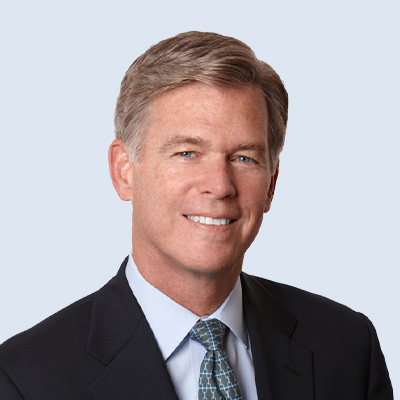Gary Tubridy: Hi. GT here, Senior Vice President at the Alexander Group. We’re here at the 2018 Chief Sales Executive Forum. I’m here with Rob Rosiello, senior vice president of Americas for Riverbed Technology. Rob, welcome to the Forum.
Rob Rosiello: Thank you so much, Gary. Great to be here.
GT: Tell me a little bit about Riverbed.
RR: Sure. Riverbed Technology is a company that is focused on digital enablement performance for our 30,000 customers.
GT: 30,000 customers?
RR: 30,000 customers. We have a tremendous legacy of working with some of the largest public and private companies in the world, as well as government institutions and our primary focus is on enabling and equipping our clients in their digital enablement and digital transformation initiatives. We do that by way of a platform, set of products that address both digital enablement management, digital experience management, whether it be applications, network infrastructure, as well as next-gen infrastructure for cloud, data center or edge technologies.
GT: Whether you’re moving dirt literally, manufacturing refrigerators or producing clinical diagnostics, they’re all going digital so business must be good?
RR: Business is good, but what’s more interesting about business being good is it affords the opportunity to really work with our clients and to address their digital initiatives.
There’s been so many studies that show every company in the world as you said is going digital today. The advent of the information age has made data prolific. What we provide is the ability to enable that digital transformation in an effective way and there are so many studies that are done that show about 80% of the initiatives that are taken on today are not executing at the kind of performance that our clients or any companies would want. That’s because they are not ready to really deal with all the different things that come along with digital transformation.
We provide both the visibility, as well as the performance infrastructure to enable our customers to hit their goals as it relates to digital enablement and transformation.
GT: Tell me about who your clients are and how that’s evolved?
RR: Our primary place with our customers tends to be the global 2000 companies over about $200 million, as well as government institutions. More importantly though and I think what you’re referring to is who are we selling to? Who are we working within the client organizations? As a technology company, quite often it is the CIO and his or her staff, but what we have found, particularly as it relates to digital transformation and business process, more and more we are working with the clients of the CIO, whether they be internal or external, the lines of business, the shared services folks in HR and marketing and sales and we endeavor to understand what their business outcome and their transformational aspirations are and as best we can get close to delivering on the promise that they’ve made to their customers and their clients internally and externally.
GT: That has got to change then, the way you package and position your products because it’s not the product, it’s what the products do. It’s the solution you bring, right?
RR: Absolutely. When we started out, like many companies, we were very enamored with product, with speeds, feeds, functions, features, the what it was and the how it did it and what we find more and more is that customers don’t care. If you think about your own real-life experience, quite often you don’t care how something works. You just want it to work with the performance you expect, with an understanding of what it’s going to deliver and how you can best achieve what it is that you want to achieve.
Towards that end, the customer is changing because we have to align to what it is they have to deliver, not what it is I’m trying to sell. One of my earliest mentors 30 plus years ago, when I asked him, “What makes for a great salesperson?” He said to me, “Stop trying to sell me and start trying to solve for me.”
GT: When we have all these new customers emerging and they find out information about products and services that you offer on the internet a long time before they speak with a seller, is there a role for the sales organization to work with the marketing organization to manage their awareness before they make that call?
RR: I think it’s critical today more so than ever. The collaborative approach that needs to occur within any organization, whether we be the sellers of solutions or the consumers, the collaborative approach is again, more relevant today than ever. We work very tightly with our marketing organization, again in concert with each other to determine things like account-based marketing, one to many based marketing, drip and nurture streams. That has to be a closed loop, however. It can’t be just the marketing team serving things up to the sales organization. We have a responsibility to bring back to the marketing organization what message is resonating, what’s not resonating, what are we learning as we go out there and pursue the messaging that they are giving us. We work very tightly. My field marketing partner is truly my partner. She works for the CMO. She’s on every one of my staff calls. She is one of the most critical pieces of the supply chain in the way that we approach the business.
GT: Tell me about that supply chain concept that you mentioned there?
RR: Supply chain obviously in the manufacturing environment and Six Sigma and lean manufacturing has been well known for decades if not centuries now and optimizing that supply chain is something that plenty of consultants and plenty of companies have pursued. We’re trying to take that same approach in terms of how do we put the right information in the hands of the sellers to target the right audience. Now that might be persona based selling, but that also might be industry information and vertical information for use cases and for outcomes that are relevant. It might be who is the next logical player to target within a company or across a set of companies.
To us the supply chain is the entire organization getting in the boat together, giving everybody oars and making sure that we are paddling in the same direction so we can get to our destination, which as a Chief Sales Officer or Senior Sales Executive is to grow profitable, sustainable revenue. That’s our job.
GT: I’m aware that Riverbed has a senior sales executive in you, senior marketing and senior success and they are under chief revenue officer, are they not? Tell me about that decision?
RR: What’s even more interesting is that they are not even under the CRO. They are peers of the CRO and I think that’s critically important to note because every one of them has a critical voice and seat at the table. Every one of them are contributors to the execution of revenue. Sales teams are accountable for the revenue, but we don’t do it alone. Just like great product alone does not sell itself without marketing, without sales. We have all three functions. Our CMO and CRO have been working together for about two and a half years now. I as SVP of the Americas, work very closely with our marketing organization, not just my marketing counterpart, but with our CMO, with our PR teams and our customer success function is actually a relatively newer function that we just instituted officially about three months ago.
GT: Did it change the interlock between sales and customer success?
RR: It did a little bit and again, we’re still kind of growing through it. I think you know what Dan Smoot who is our Chief Success Officer has brought to the table is a different lens of the analytics.
I think that’s really important. Every senior leader has to look at the analytics within the stove pipe of their organization and then how do you expand beyond that to make sure that there is interlock? What Dan has brought to the table from a customer success standpoint is a different lens of those analytics. It’s the, let’s not only look at when a customer is renewing or what their renewal rates are, let’s look at what their adoption has been and why. What trends have we seen? How can we get out in front of some of those things in such a way that we’re not only doing the customer satisfaction survey, but we are then integrating that into every attribute of our selling motion.
GT: What does a sales or revenue leader today need to be really good at?
RR: Balance, patience. I think you have to be able to anticipate and look around the corner as to what’s coming because if there is one thing that I think we can all implicitly and explicitly understand is time never stands still. What works today is not necessarily going to work perhaps even 90 days from now. I think you have to strike that balance between strategy, having a strategy that is clear, that is concise, that is actionable, but then you also have to be flexible enough within that strategy to anticipate, to adapt as required and again, when I said balance at the outset, I think as the team that is closest to the customer, it’s so critically important that you are bringing that balance conversation back into the organization in the spirit of collaboration and comradery to serve the customer.
GT: No finger pointing. It’s all about the customer.
RR: No finger pointing.
GT: What’s around the corner for you?
RR: We are a company that is very much proud of our legacy. We have been consistently one of the top performers in our legacy network infrastructure portfolio and we continue to innovate in that space and that innovation really is adapting to what is going on in our client-centric world. You think about where we were a decade ago, there was no such thing as this thing called the cloud. The cloud is one of the more pervasive technologies today. Software as a service, moving workloads through different places, so we continue to adapt the way the customers need and want to consume and that is affecting our product innovation and our product roadmap.
Secondarily, I mentioned at the outset that we’re now a platform company, so what’s around the corner for us, you will see Riverbed become more of a software-centric, visibility, digital experience management company at the forefront of what we do, as opposed to the network infrastructure side. Underneath that, we then have the great network next-generation infrastructure technology to improve what we’ve been able to diagnose through our visibility.
GT: Outstanding. Rob, thanks for joining us. Appreciate it.
RR: My pleasure. Thank you.

